URLINGAME B THE
Girls’ mental health in crisis

 BY ELISE SPENNER Managing Editor
BY ELISE SPENNER Managing Editor


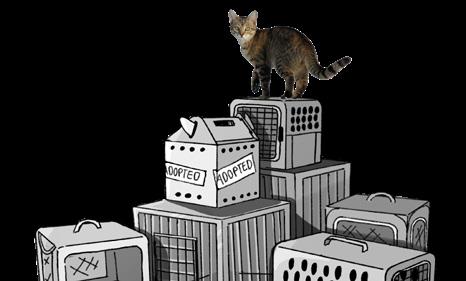
In February, the Centers for Disease Control and Prevention (CDC) published data nding that 57% of U.S. teen girls felt persistently sad or hopeless in 2021 — an almost 60% increase from a decade ago. Burlingame, according to the results of the Burlingame B’s anonymous survey completed by 79 female-identifying students, is no exception.


“How are you?”
When junior Olivia Fleming read that question on a form at the doctor’s o ce in summer of 2020, she started crying.
“It was hard to get the words out,” Fleming said. “I remember my Kn95 mask was drenched with tears. Looking back on it, it’s very surreal.”
It had been months since Fleming had last seen her friends. Without schoolwork to distract her and peers to spend time with, Fleming spent hours per day on TikTok.
“I would be in bed, and my thoughts would just kind of be like a cloud around me,” Fleming said. “ ere wouldn’t be any place to escape, so then that cloud would just kind of accumulate. And there was no way to get past it. ere was no ‘Okay, I have to wake up. I have to go to school.’ ere was just ‘I could stay in bed.’”
Fleming was grappling with her identity, while under intense academic pressure, with the added burden of social media — amid a global pandemic.

“It was just kind of this spiraling e ect,” she said.
For senior Emily Geraghty, that spiral started in seventh grade, when her best friend moved to a di erent middle school. Without friends to turn

to, Geraghty was isolated.

At the time, she also had undiagnosed ADHD, making school work almost impossible.
It was obvious that something was wrong, but Geraghty didn’t know how to share her feelings.
at reticence began in elementary school, when students nicknamed Geraghty “EM-otional” for showing her feelings. Afraid of being a burden or being teased, Geraghty learned to feel less.



“I think it comes from middle school and elementary school of just not knowing how to deal with it in a healthy way,” Geraghty said. “So I just didn’t deal with it at all.”
Although avoidance worked in the short term, it contributed to nagging, incessant fears about the future — a combination of intense anxiety and depression.
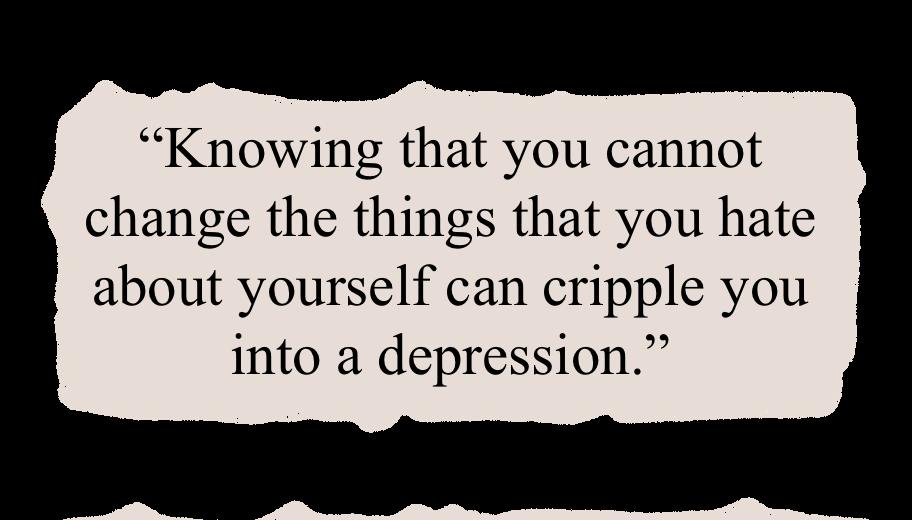
“I can see no future because I can’t even do my English essay,” Geraghty said. “How can I have a job? How can I go to college? How can I do anything?”
e pandemic made everything worse: Con ned to her house, she lost any connection to students or the classroom. Between November 2020 and March 2021, Geraghty didn’t speak to a single person outside of her family.
“It was the worst moment of my life. I think in 2020, I had reached a breaking point in myself. at hopelessness. I did not see any type of future for myself. I had those scary thoughts of ‘I don’t want to be here anymore.’” Geraghty said. “And thank God, I was scared. I was still wanting to be here at least a little bit.”
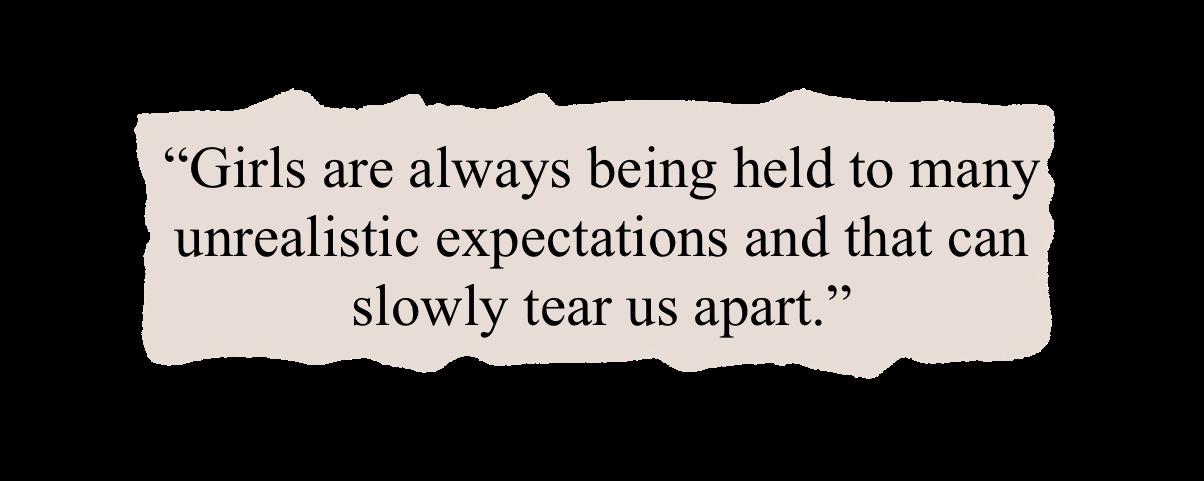
See NEWS, page 2
Amanda Nolan and Sophia Doss contributed reporting.
District naloxone program installed in response to growing use of fentanyl
BY JEANNINE CHIANG Sta Reporter
With fentanyl overdoses surging on a local and national level, the San Mateo Union High School District (SMUHSD) has taken enterprising steps to be prepared if a student were to experience an opioid overdose while on school campuses. e district o cially implemented the Naloxone program on Mon-
day, Feb. 27, stocking life-saving Naloxone nasal sprays (otherwise known as Narcan) on campuses.
According to the San Mateo County Coroner 2021 Annual Report, 134 of the 5,861 deaths recorded in San Mateo County were overdoses in 2021, up 13.5% from the 118 in 2020. Of the 134 accidental overdoses, 83 tested positive for opioids, and of those, 71 cases tested
positive for fentanyl. Although it is unlikely many of those overdoses came from high school students, administrators will be prepared for any emergency that occurs.
“If a student is unconscious and unresponsive, and there’s the possibility [that] they have taken fentanyl, then [Narcan] would reverse the e ects and save a student’s life. is [program] was put into place in or-
der to protect students’ health and safety,” Assistant Principal Aimee Malcolm said.
Naloxone can reverse overdoses from opioids like heroin, fentanyl and prescription opioid medications. According to Sara Devaney, the SMUHSD manager of Health Services, the opioid converse will be stored in all school sites’ health o ces, athletic training o ces and AED storage boxes by March.
“Entire towns and cities are falling because of the [opioid] crisis. We want to be preventative so that if somebody gets their hand on the pill, and they go down, we can intercept it, give the medication and save a life versus having to deal with a fatality,” dean of students Nicole Carter said.
See SPREAD, pages 6/7
March 13, 2023 Burlingame High School, 1 Mangini Way, Burlingame, CA 94010 Issue 5 Vol 137 WHAT’S INSIDE Cat population dwindles at SPCA 4 5 8 12 Burlingame students catch waves Boys’ lacrosse on the come up Meet our food in uencers
When the B asked female-identifying students to refect on the mental health crisis in an anonymous survey last month, this is what they said.
GRAPHIC BY SOPHIA BELLA
Editor-in-Chief Jackson Spenner
Managing Editor Elise Spenner
Design Editor Sophia Bella
Sports Editor Michelle Moshkovoy
Head Photographer Jake Rothstein
Business Manager Alex Kelly
Social Media Manager Amanda Nolan
Web Editor Arda Inegol
Diversity Coordinator Lizzy Wan
Social Coordinator Kristie Kim
Copy Editors
Arshia Chakravartti
Isabel Liu
Senior Reporter
Daria Burnosova
Staff Reporters
Theo Au-Yeung
Athena Bostonmaer
Jeannine Chiang
Danny Conway
Sophia Doss
Natalie Gyde
Joelle Huysmans
Brinda Iyer
Abby Knight
Will Kriner
Ana Lunaparra
Ellie Neuman
Zachary Newman
Sophia Puzon
Ruby Rosenquist
Zach Shapiro
Teacher Adviser
Melissa Murphy
Policy Statement:
The Burlingame B is a student-run newspaper with the role purpose of providing an open forum for student expression. Anything printed represents the opinion of the writer, but not necessarily that of the Burlingame B staff, the administration, or the faculty of Burlingame High School, or anyone affliated with the San Mateo Union High School District. The Burlingame B does not discriminate against race, political oritentation, ethnicity, religion, gender, sexual orientation or disability. Although The Burlingame B will never refuse to publish guest submission based on the aforementioned factors, we reserve the right to edit or not publish them.
Letters to the Editor
Disagree with the writers? Bring your letters to the room A120 or email them to <theburlingameb@gmail.com>. Letters may be considered for publication. The Burlingame B reserves the right to edit for clarity, length, and accuracy. We welcome all comments.
Website: www.theburlingameb.org
Phone: (650) 558-2899

Email: theburlingameb@gmail.com
Address: 1 Mangini Way, Burlingame, CA 94010
CICO program: students’ last chance
BY JAKE ROTHSTEIN Head Photographer
When student success coordinator Leslie Trevino-Escoto rst asked Daniel, a junior at Burlingame, to join the Check-In, Check-Out (CICO) program, he was opposed to participating. But a er his rst six-week session, he asked if he could join the program for another session. Now with the support of his CICO mentors, Daniel (whose real name is withheld to protect his privacy was able to secure an electrician internship and get on track for community college.
“My initial reaction was, I didn’t want to do [the CICO program] because I didn’t want to have someone breathing on me about doing homework,” Daniel said. “By doing the CICO program, they helped me get into meetings with an electrician company, and they’re going to make me an intern during the summer, and if I’m lucky enough, a er graduating, I’m going to be o ered a job.”
Burlingame launched the CICO program last spring where teachers serve as mentors and work closely with students in all areas, including time management, classroom engagement or self-advocacy skills.
Candidates for the program are identi ed by a few factors: counselor recommendations, D/F lists, wellness referrals and Grade Guardian, a data-driven so ware that identi es at-risk students. A er students are chosen, they are individually matched with a teacher mentor by Trevino-Escoto, the head of the program.
“[CICO] is not a volunteer kind of thing anymore, It’s more of a requirement. is is [the students] nal resource that they’re going to get before they fail,” Trevino-Escoto said.
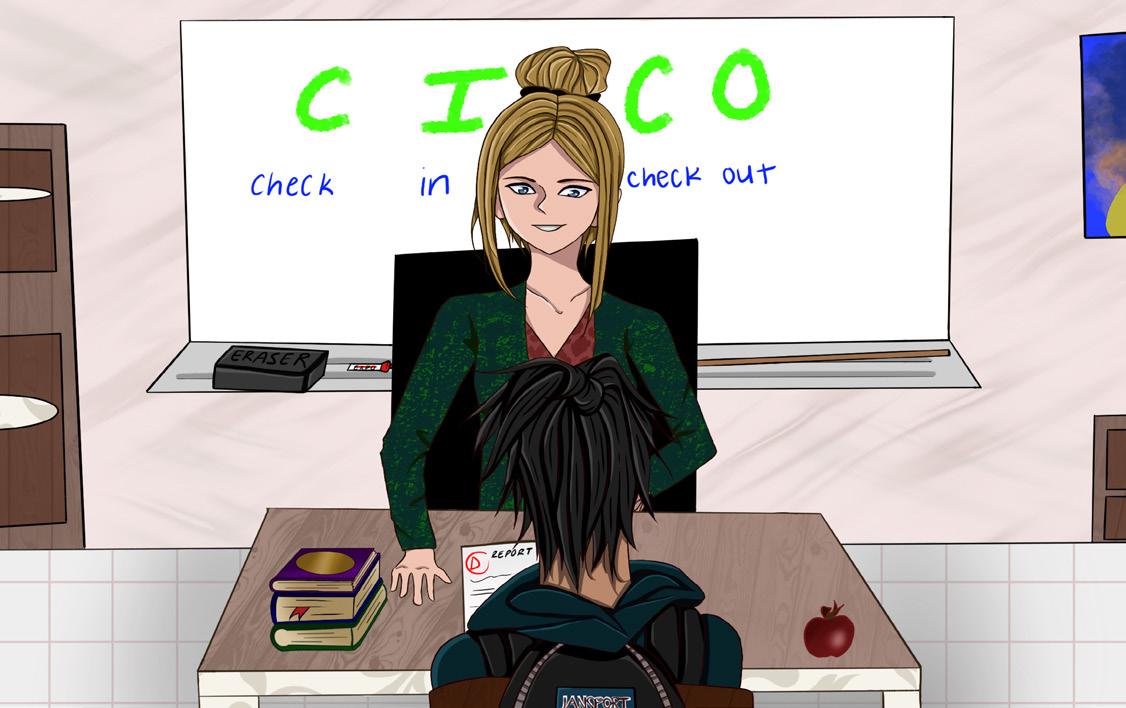
A growing number of teachers are stepping up to participate in the CICO program, which currently boasts 26 mentors. One of those teachers is Matthew McDermott, who has participated since the start of the program and is currently mentoring one student. Besides helping the student manage their coursework, McDermott also said that mentors can assist with teacher interactions.
“If I ever email a teacher about a student, that’s more impactful than if a student emails a teacher,” McDermott said. “ e teacher knows that I am their CICO, and that creates more of a connection [for the student] in the network of the school.”
To avoid impacting students’ learning, mentors are required to only plan meetings before or a er school hours.
“[Students] meet twice a week for less than 20 minutes depending on the student’s needs [but] it depends on the goal that they’re trying to accomplish,” Trevino-Escoto said. “It could be academic, it could be social. work, attendance — it just depends and varies by student.”
e program has already seen positive results, with the majority of students improving both their grades and attendance, leading to better overall school performance.
“We saw a great amount of
students achieving their academic goals, meaning that students coming in with Ds and Fs, no longer have Ds and Fs, they actually have Cs or higher,” Trevino-Escoto said. “Another accomplishment that I’ve seen was the attendance. A lot of these students also had attendance issues, but with the CICO program they have alleviated that.”
ough the program does see success from many of its students a er the six-week program ends, Trevino-Escoto re-enrolls those that regress into poor academic performance.
“ e other side of the coin is, we have students coming in for six weeks, and then they completely fall,” Trevino-Escoto said. “Not every student is going to have the best experience [in the CICO program], but they eventually [will] have good grades, and [if they fall] we start catching them again and put them back into the program.”
In the case of Daniel, the CICO program not only helped him secure an internship but also drastically improved his grades.
“I think it’s had a big impact on me because I have grades that I thought I would never have had,” Daniel said. “Being in the CICO program and having someone mentor me throughout the way helped me a lot.”
Teenage girls grapple with mental health
FROM PG. 1
Eventually, Geraghty and Fleming both sought and found help from medical professionals. But their circumstances aren’t unique, and they are far from alone at Burlingame.
In the B’s poll, 57.7% of respondents said they felt sad or hopeless sometimes, frequently, or all the time — identical to the national average recorded by the CDC. While the CDC found that 30% of female high school students seriously considered attempting suicide, 46% of survey respondents said they have experienced suicidal thoughts.
While the CDC does not track data on self-in icted injuries, the B’s survey also found that two-thirds of respondents have considered harming themselves, and 64% know rsthand someone who does harm to themselves.
Importantly, mental health challenges take no single shape or form. Unlike Fleming and Geraghty, sophomore
Joyce Gong rejoiced when the COVID-19 pandemic shuttered schools and con ned students: She could wake up whenever she wanted; she didn’t have to go outside; she could avoid peers and classmates. But two years later, her isolation made returning to school that much harder.
“I locked myself in and coming out was extremely nerve-racking because I hadn’t been around people for years, and I wouldn’t go outside,” Gong said. “And then just remembering that people in class can look at you and like eyes can be on you. It’s extremely nerve-racking.”
During sophomore year, Gong’s support network “kind of all fell through.” Gong said her home life, schoolwork and social expectations piled up.
“I feel like you can
only have two in high school: grades, social life, mental health or sleep,” Gong said. “And I really chose grades and a little bit of sleep. I kind of messed up.”
Each student we spoke to said that school pressure exacerbated their mental health struggles. It felt, both Fleming and Geraghty said, like all or nothing — “I just didn’t care anymore if I wasn’t going to be that great student,” Fleming recalled.
“Why play the game if I know I can’t win?” Geraghty said. “It’s just like if it’s not perfect, it’s not good enough. And there’s no point in trying.”
NEWS MARCH 13, 2023 2
GRAPHIC BY BRINDA IYER
B
THE BURLINGAME B
READ OUR FULL STORY HERE
Gender stereotypes reaffirmed by AP enrollment
Porto said. “I feel like this gender gap really discourages girls in our school from wanting to join these advanced STEM classes because they don’t feel represented or included in the class. It makes girls think that they aren’t capable of excelling in these advanced classes since they are mostly male-dominated.”
English and boys are good at math.”
positive learning environment.”
BY LIZZY WAN Diversity Coordinator
Although each gender is enrolled in Advanced Placement (AP) classes at a similar rate — 52.9% are female and 47.1% are male — female-male disparities are wide in individual courses at Burlingame.
Speci cally, classes such as AP Biology, AP Italian and AP English Literature are nearly 70% female, while AP Physics is 65% male and AP Calculus BC is 60% male.
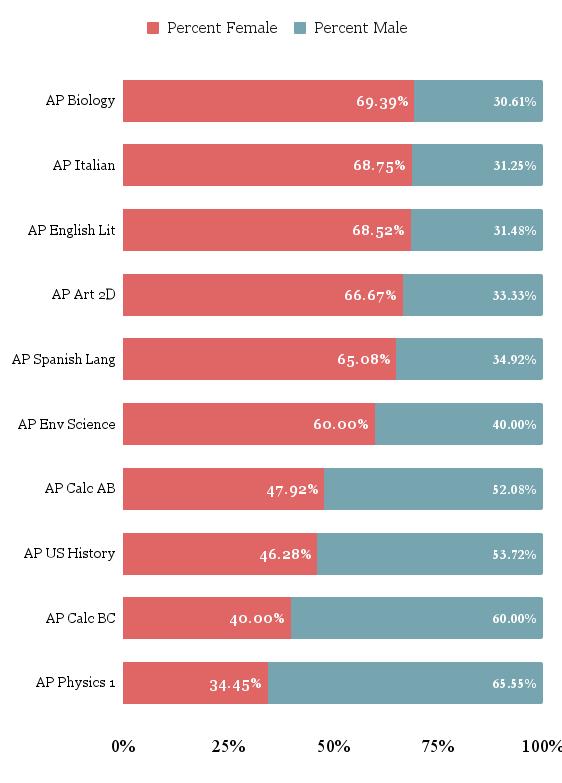
e same is true across the country: Ten years ago, the College Board released its “10th Annual AP Report to the Nation,” including statistics on the student makeup for AP courses and tests. Overall, the report revealed that most AP classes are dominated by one gender: Typically STEM-based courses have more males, while
humanities and arts tend to attract female students.
“I think part of it is socialization. As a female you’re socialized to be agreeable, you’re socialized to think about others, you’re socialized to be a caretaker,” AP 2D Art teacher Eislyn Wolf-Noyes said. “ e arts is de nitely a place where you can feel your feelings and English and stu like that. Men are socialized to solve problems, to be strong, to be independent. I think that carries over unnecessarily into the subject matters.”
However, when that bias in uences gender enrollment — two-thirds of Wolf-Noyes’ students are female — it can become detrimental to the overall class environment.
“In my AP Computer Science class, there are only about six girls in my class compared to around 20 boys,” senior Clara
AP Computer Science teacher Christina Wade witnesses the disparity rsthand in her class and does whatever she can to help give her female students the extra boost they need — either giving them extra encouragement in class or allowing them to work with friends to increase con dence on projects.
“I feel like a lot of girls are kind of nervous to take classes that are out of their comfort zone or that they have no experience,” Wade continued. “And when they get into the class, a lot of the people that have experience are usually boys. And so sometimes, in the beginning, they feel very intimidated.”
On the other end of the spectrum, classes like AP Language and Composition and AP Literature tend to be female-dominated.
ere’s all sorts of stereotypes and preconceived notions about what girls are good at and what boys are good at that sort of play into this conversation,” AP Literature teacher Tim Larkin said. “ e old stereotype would be that girls are good at
While the gap in said classes is apparent, not everyone feels a ected by it. Senior Alejandro Contreras has taken classes with gender disparities that skew in both directions — AP Computer Science, AP Physics and AP Literature — yet does not feel a ected by such imbalances.
“I haven’t noticed any gender gaps in any of my AP classes throughout high school,” Contreras said. “However, they do exist, and I recognize that they may be impediments towards a
Ultimately, regardless of the ratio of male to female students in each class, teachers said it is most important to create a welcoming environment where all students can voice their opinions without fear of judgment.
“If you’re teaching physics, calculus, AP Lit, ceramics, you want everybody to come in and feel like they have a place there, regardless if they feel like they’re part of a majority or a minority or neither,” Larkin said. “You want everybody to feel like they can be their best selves.”
Administration sees decline in ditching with new policies
Campus safety specialist Phillip Iniguez said that he hasn’t seen students ditching recently, especially since his team began guarding the main entryways of the campus during times students were likely to skip.
“I’d say earlier, maybe last semester, there was a pretty big increase in students going o campus,” Iniguez said. “We had to remind them that it’s a closed campus and you can’t just leave whenever you want.”
Despite e orts to reduce truancy rates, some Burlingame students still choose to ditch class. According to lead wellness counselor Christina Cabrera, an increasing number of students have reported missing or avoiding school due to heightened social anxiety.
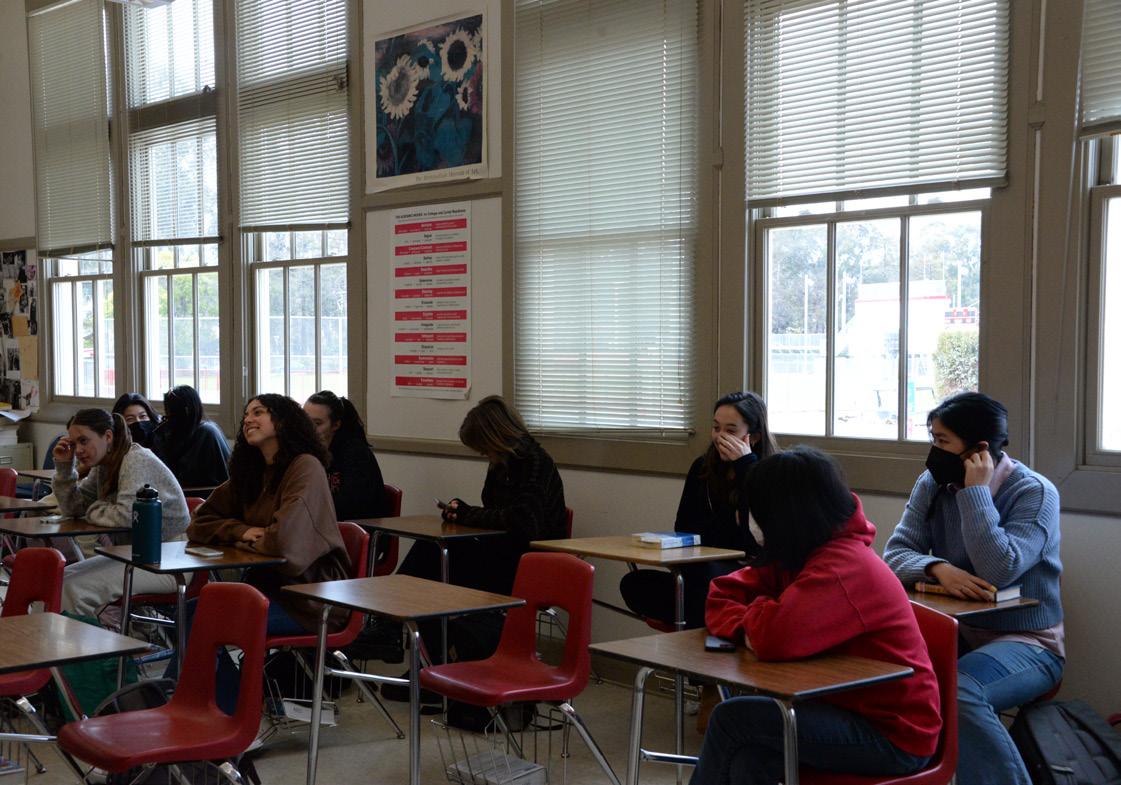
es. Even with having the work in Canvas, it’s not the same as being in class.”
To support students struggling with social anxiety, the district’s School Attendance Review Board has implemented several strategies. ese include providing counseling services, o ering exible scheduling options and encouraging teachers to create a more inclusive and welcoming classroom environment.
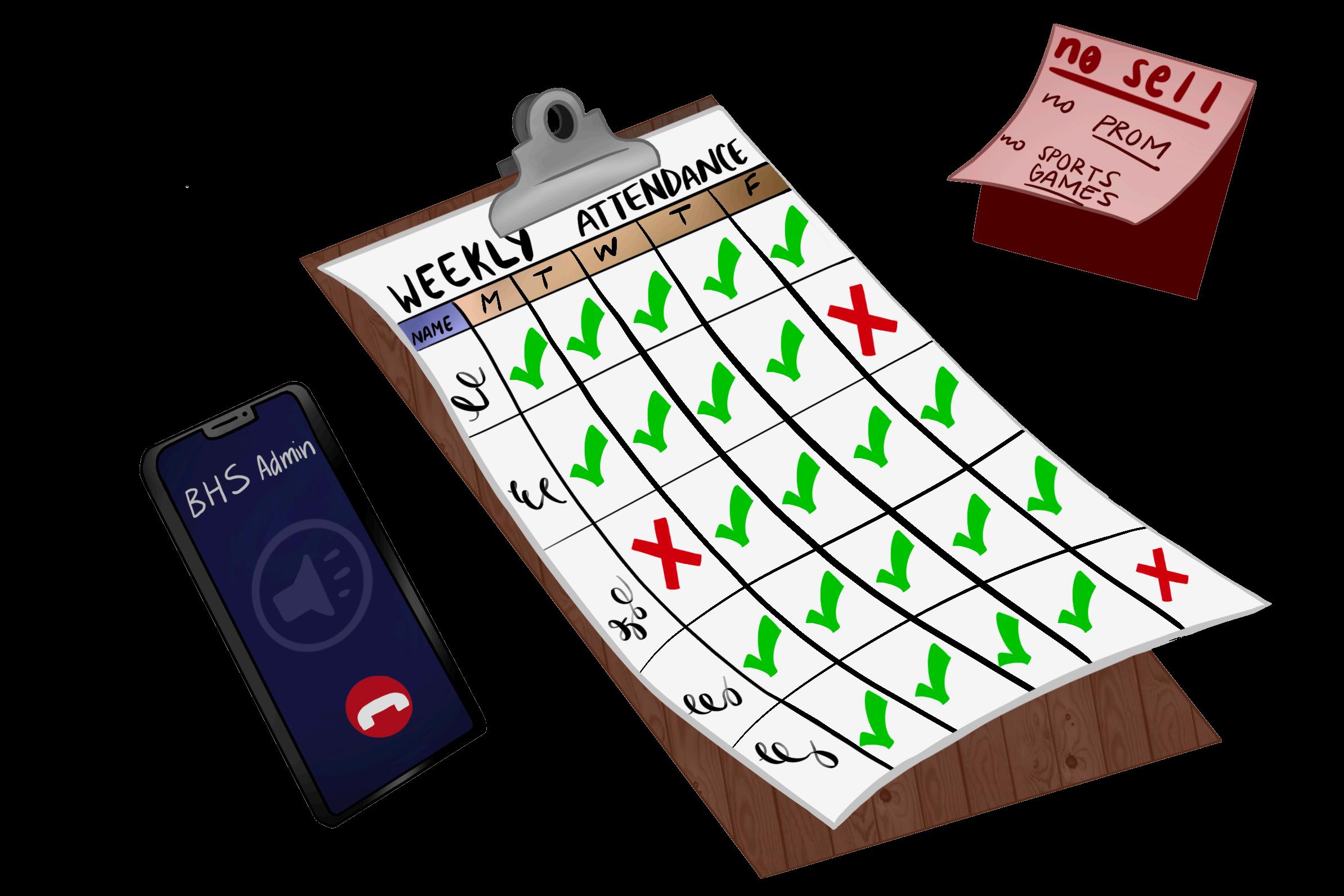
Moreno also sees a pattern in students that don’t show up to class: ey’re usually the ones with lower grades, showing how skipping school can put a strain on their academic performance.
“Class time is valuable and there’s a reason why students must attend class,” Moreno said.
BY SOPHIA PUZON Sta Reporter
As the school bell rings and students hurry to their classes, some take the opportunity to leave campus, deliberately abdicating their academic responsibilities. However, a er a surge in truancies in late 2022, school administrators implemented stricter measures to combat ditching — and it seems like they’re working.
According to the Burlingame website on Progressive Discipline Process, cutting class
is designated as a “level 1 consequence.” Potential administrative responses to ditching include suspension of school activity privileges or a parent conference. In addition, Burlingame has implemented weekly detentions speci cally to discipline truancies and tardies.
ese policies have actually caused the number of truancies to decrease signi cantly. According to the attendance clerk Roxanna Moreno, the implementation of weekly detentions and the “no sell list” — a run-
ning tally of students prohibited from buying school merchandise and participating in dances and other activities — has discouraged students from skipping class.
“On a weekly basis when I’m running the reports [of] the list of students being late to classes or truant is actually going down,” Moreno said.
Not only has the number of truant students gone down, but students seem to be less compelled to ditch during school hours compared to last semester.
Social anxiety can make it di cult for students to attend class, and can be caused by a variety of factors, including academic pressure, social expectations and personal insecurities. A student who has skipped school in the past said that it can quickly become a weekly, or even daily, ritual.
“You can easily fall behind and face feeling really overwhelmed,” they said, adding that these overwhelming feelings can perpetuate anxiety. “It can be hard to keep up in class-
“But at the end [of the day], honestly, you’re really missing out and it is impacting grades.”
None of these policies which combat truancy are completely new, but they are being reinforced. Because truancies are now linked to students’ ability to purchase merchandise, attend dances and participate in other extracurricular activities, it’s clear students have started to realize the impact of skipping school not only on their grades but their holistic high school experience.
NEWS MARCH 13, 2023 3
Between its two classes, AP Literature has 37 female students and 17 male students.
GRAPHIC BY BRINDA IYER
PHOTO BY LIZZY WAN GRAPHIC BY JACKSON SPENNER
Adrian Zhang: from bird enthusiast to activist
BY ELLIE NEUMAN Sta Reporter
Humans are in constant interaction with the estimated 50 billion birds on this planet, whether on neighborhood streets, in the school courtyard or on the bayside shore.
While many of us walk by birds without batting an eye, this is far from the case for senior Adrian Zhang. From working with a nonpro t pigeon rescue, spending countless hours researching and bird-watching, to aspiring to nd a career working with birds, Zhang has made these creatures a key part of his life.
Zhang rst found his passion for birds when, at 12 years old, he came across “ e Genius of Birds” by Jennifer Ackerman in a bookstore.
“I read that [book] and I think it really opened my eyes to how amazing even the most ordinary birds are,” Zhang said. “I think that’s what made it really easy to start loving bird watching — it’s that birds are everywhere and we kind of take them for granted and how cool they can be.”
Since developing his passion for birds, Zhang has spent a lot of time doing in-depth research about the creatures.
“I read scholarly articles for fun in my free time about birds,” Zhang said. “I’m doing my AP Lit inquiry project on birds… ere’s a lot that we can learn from them, like we’ve used hummingbirds before and how you know, song learning works in their brains to understand human neuroscience and try and solve problems like speech disorders or Alzheimer’s.”
And Zhang’s favorite bird
Empty
BY NATALIE GYDE Sta Reporter
happens to be one of the most common: the American crow.
“I really like American crows because they’re everywhere so you can always see them,” Zhang said. “And also they’re very intelligent… …they’re smart, they’re loving and they’re not as scary as people believe they are. ey’re basically just, you know, puppies.”
Last summer, Zhang expanded his passion for birds by joining Pigeon Palomacy, a pigeon rescue in the San Francisco Bay Area that saves lives of domestic pigeons and doves by providing vet care, foster homes and adoptions. Founded in 2007, Palomacy has helped over 1,400 birds.
Zhang volunteers at Palomacy every Saturday, cleaning the facilities and taking care of the birds at the aviary. Additionally, he spends a lot of time working on outreach projects through Palomacy.
“We do outreach programs where we take our ambassador birds out to meet people and they’re very sweet and I think this just helps people see that,” Zhang said. “And it really helps people be more aware of issues surrounding things like people breeding pigeons to be released at weddings, people breeding them for racing. And just how they can be abandoned because we don’t really see pigeons for
what they are.”
Zhang also helps run Palomacy’s online outreach programs, such as educational Facebook streams.
“We do these events, because you know, we just really want to reach out to the larger community and you know, educate them about these birds,” Zhang said.

As expected, working with Palomacy has further deepened Zhang’s love and appreciation for birds.
ey’re just really fascinating because they’re so di erent from us and other animals that we regularly interact with, like dogs or cats, but they’re super
sweet,” Zhang said. “And they’re just a joy to work with once you get to know them… ere’s stu that you get from hands-on experience that you could never get from just a book.”
According to Zhang, most of the birds in Palomacy’s aviary are King Pigeons, which are bred speci cally by humans to look beautiful and therefore have inadequate survival skills to live in the wild. Most of the birds he works with are non-releasable raised in captivity. However, when Palomacy does nd a feral pigeon that can be released into the wild, they release it.
Aside from working with Palomacy, Zhang has also volunteered with the Golden Gate Audubon Society, where they work to enhance the habitat of shorebirds through service projects, such as picking up trash and clearing away invasive plants.
Zhang plans to major in Biology and Environmental Science at Reed College, where he can conveniently volunteer at Palomacy’s Portland branch. Zhang aspires to become an ornithologist as an adult — a person who studies and is an expert on birds.
“I just really want to make birds my life,” Zhang said. “...I want to make discoveries about birds that are going to help both preserve birds and improve human life.”
Aside from birds, Zhang’s interests include drawing, gaming, music and most uniquely, writing plays and musicals.
“I would absolutely love to also pursue a little bit of playwriting and workshops when I’m in college,” Zhang said. “ ere’s always room for more these days.”
kennels and cages: why the SPCA is down to one cat
ing to live in the wild.
months, contributing to the lack workload. many people,” McDonald said.
During a typical winter, the Peninsula Humane Society and the Society for the Prevention of Cruelty to Animals (SPCA) is full of animals, with anywhere from 10 to 15 cats waiting to be adopted and taken into loving homes. But this March, that number has dwindled to just one — and the shortage of animals may have serious consequences. e Peninsula SPCA’s Communications Manager, Bu y Martin-Tarbox, has experienced rsthand this decrease in cats.
“Timing of the year is important in terms of the feline population in our shelter. It is winter, so generally our population of cats is lower, but I’ve been here at Peninsula Humane Society for six years, and I’ve never seen this few cats this time of year,” Martin-Tarbox said.
Each year, around 800,000 animals are placed in shelters in California like the SPCA where they are cared for instead of hav-
“We do have animal control o cers that operate 24/7. But if we get calls from people and they have a cat in their backyard that they’ve been feeding, we work with those people and we will provide for them cat traps and let them know the best way to trap that cat,” Martin-Tarbox said.
Even so, some cats remain homeless, breeding and increas ing their populations. In accor dance with recent California laws, the SPCA helps to slow the homeless animal population by spaying and neutering wild cats.

“Shelters throughout the Bay Area generally do a really good job of spaying and neutering not only cats who go through shel ters but those who are out in the wild,” Martin-Tarbox said. “By spaying and neutering, that’s also reducing the cat population as well.”
But when the reproduc tive rate slows for animals in the shelter, the population de clines. And adoption rates have increased within the past few
Senior Adrian Zhang holds a King Pigeon while volunteering at Pigeon Palomacy’s aviary.
PHOTO COURTESY OF ADRIAN ZHANG
FEATURES 4 GRAPHIC BY ISABEL LIU MARCH 13, 2023
Catching waves: Sur ng o ers emotional outlet for students
“Every day’s something different out in the water, the waves can be rocky, they can be one foot, or they can be really good waves, so I think every time that I paddle out into the water, I get something new, which I think is great,” Callentine said.
For surfers like Burlingham, sur ng goes hand-in-hand with other sports, especially water polo.
“Sometimes you’ll be pounded by three waves in a row and you’ll be exhausted but you have to push through so that you’re not stuck in the next set,” Burlingham said. “And that kind of mentality and that mental fortitude comes in help for water polo, when you’re exhausted but have to get up and block that shot.”
BY ELLIE NEUMAN Sta Reporter
e sport of sur ng, which originated in Hawaii and spread to the United States through Southern California, has become a staple of the West Coast stereotype. According to Surfer Today, 29% of U.S. surfers now live in California — a population which has seen notable increases since the pandemic. With the coastal shores of Half Moon Bay and Paci ca just 30
minutes away from campus, the accessibility of sur ng attracts many Burlingame students, who have taken up the sport as a calming pastime.
Senior Tarik Burlingham, who has been part of the local sur ng scene since he was around four years old, surfs multiple times each week as an outlet to clear his head.
“It gives me time to re ect and not think about other things going on. It’s a lot more than just waiting to catch a wave,” Burl-
ingham said. “It’s like a rhythm almost... and you’re not thinking of anything else but the open canvas and the wave that’s ahead of you, and whether you want to go up or down the wave… it’s an amazing feeling.”
However, it’s not just experienced surfers like Burlingham who have taken up the sport. Seniors Sasha Grett and Jamie Callentine decided to take some lessons together with zero experience a er seeing sur ng videos all over TikTok in 2020.

Senior and varsity water polo athlete Kelsey McDonald is also eager for time in the water and has been sur ng with her father since she was 12 years old.
“I’m a swimmer and water polo player, so just being in the water is relaxing to me,” McDonald said.
Both McDonald and Burlingham said that morning is the optimal time of day to surf, due to the minimal o shore winds. On rare occasions, Burlingham has even woken up to go out before school.
Regardless of the conditions, even experienced surfers like Burlingham are constantly being knocked over by waves, but perseverance is a major element in the sport. “ ere’s a point at which when you’re kind of taken by a huge wave that you realize you’re along for the ride,” Burlingham said, “And that’s when another kind of moment of calm comes along... because you know, you’re gonna wait it out.” Burlingham, McDonald, Callentine and Grett all agree on the abundance of good sur ng spots in the Bay Area. Popular ones nearby include Linda Mar, Rockaway beach, and Montara State Beach. Although it is an hour-long drive, Santa Cruz is also known for its prime surf spots.
Spending time on the water has certainly le a positive impact on many students, especially Burlingham.
“It’s so much more than surfing,” Burlingham said, “It’s not just, you know, getting out on the water with a piece of berglass. It’s nding a quiet and peaceful space to re ect on what happened that day… where there’s no one really around you except good-natured people.”
U.S. government weighs TikTok ban amid privacy concerns
would enforce a ban on TikTok across the country.
Such a ban would be most consequential for young individuals — 25% of the app’s one billion users are between 10 and 19 years old. at includes students at Burlingame, some of whom said the threatening prospect of Chinese government ofcials spying on American users makes the app less appealing.
“I am worried to put myself out there because my private [information] could end up getting exposed,” sophomore Sophie Berkovitz said. “I think that TikTok, on their part, should nd ways to be more secure for younger users.”

Junior Mason Rosales, for one, believes that taking collective action is important when addressing the issue.
is imminent, limiting screen time is a strategy that many experts recommend to promote healthy cognitive development. In accordance with this belief, on March 1, TikTok announced that it would be setting a 60-minute screen time limit for all users under the age of 18. When young users hit the hour mark, they will now receive a noti cation that requires them to type in a passcode to continue. If they choose to disable the passcode and spend more than 100 minutes on the app per day, TikTok will prompt them to set their own time limit.
erage of 90 minutes per day.
“[TikTok] is fun to look at,” Diehl said. “However, I nd myself scrolling through my recommended videos for an extensive amount of time, which is unhealthy.”
Similarly to Diehl, other students seem to be reconsidering their relationship with TikTok.
“I don’t like how there are people on the app who con gure themselves to unrealistic standards,” sophomore Sophie Berkovitz said. “I don’t think that TikTok cultivates a healthy environment because of comparisons that throw people o .”
BY RUBY ROSENQUIST Sta Reporter
e United States government has taken steps to ban the popular video-sharing app, TikTok, in recent months, citing concerns over the handling of user data and potential national security risks posed by the app’s Chinese ownership.
Speci cally, U.S. lawmakers have alleged that the Chinese government is using the popular social media app to collect sensitive user information such as names, ages, locations, face-
prints and voiceprints.
Additionally, elected o cials fear that TikTok’s algorithm may be used to push harmful content onto users’ For You pages, highlighting the need for increased regulation on the app.
In response, 30 states have banned TikTok on government devices, according to Forbes.
Universities in Arkansas, Mississippi and Texas, among others, have followed suit, banning TikTok on school networks.
Last month, two U.S. senators reintroduced the wide-reaching Anti-Social CPP Act, which

“ e amount of time that kids spend on TikTok without realizing their [risk of] privacy is concerning,” Rosales said. “Making [the ban] up to the states would probably be the best course of action.”
Beyond privacy concerns, students expressed that a TikTok ban could prove bene cial to their mental health and productivity.
“I would de nitely have more time to do things that need to get done in my life if [TikTok] was banned,” junior Elizabeth Diehl said. “Outside of the platform, there are opportunities to form stronger connections with friends and family.”
Whether or not a TikTok ban
“I think that [the time limit] is a good way to remind users to take a break from their phones,” junior Abi Scully said. “But I think that many people, including me, are going to ignore the time limit and keep scrolling.”
Before this 60-minute restriction was put into e ect, the average person spent 45 hours on the app per month — an av-
But ultimately, it seems unlikely that the majority of teenagers will be pleased with government restrictions on the app.
“I like watching videos that make me laugh and that I can relate to,” Diehl said. “If TikTok were to get banned, I wouldn’t have that immediate distraction to give me a sense of ful llment.”
FEATURES MARCH 13, 2023 5
Seniors Tarik Burlingham and Zane Allred carry their boards before sur ng at Pleasure Point beach.
GRAPHICBYDARIA BURN O S O V A
PHOTO COURTESY OF TARIK BURLINGHAM
INVESTIGATING DRUG USE
EXPLORING THE PREVALENCE OF DRUGS ON BURLINGAME’S CAMPUS
there’s o en little that sta can do about it.
When given a bathroom pass, teachers expect students to go to the restroom and quickly return to their classroom. But during that time, students are given a degree of autonomy. Even if teachers provide guidelines for appropriate behavior outside the classroom, they have little control over their students.
“I try to always assume best intentions when interacting with the teenagers I support,” English teacher Bethany Li said. “[But I know that] there is a percentage of students that are socializing or possibly doing inappropriate things in the bathrooms because I’ve heard reports of these incidents.”
O en, “inappropriate things in the bathrooms” include drugs. According to the National Institute on Drug Abuse, 21.5% of 10th graders and 32.6% of 12th graders reported participating in any illicit drug use in the past year as of December 2022.
An anonymous student, referred to as Ava to protect her con dentiality, admitted to leaving classes and going to restrooms to ful ll nicotine cravings.
“I feel like anyone that’s addicted to any [drug] a er not ful lling that urge for seven hours, they would de nitely be more inclined to do [more drugs] throughout the day,” Ava said.
ough teachers may be able to tell when a student is intoxicated,
“I mean, there are some obvious signs [when students have done drugs] if they’re acting very strange, but I don’t really think it’s my job to analyze every student I have every day to see if they’re high or not,” history teacher Joshua Gnass said. “Drugs are a part of public education. Some kids do drugs, it’s part of life.”
As Gnass said, substance abuse has become a key part of teenage culture. irty percent of teens are pressured to use drugs in middle school or high school, the Substance Abuse and Mental Health Services Administration found.
“Drug use is glamorized during school, and people can get a skewed image of drug use and they can take it less seriously than they should be,” sophomore Ella Wang said.
Drugs are not only normalized among teens — they’re very accessible. A study by the National Center on Addiction and Substance Abuse reported that 25% of teens claimed they could get marijuana within a day. Drug awareness association Teen Rehab reported 35% of 12th graders claimed the opioid “ecstasy” was fairly easy to obtain.
“Being a teenager in social and party settings, drugs practically surround you. It’s usually nicotine
or weed, but people [who] bring those out at a party setting [also have them] in school,” Ava said.
“I’m sure at least half the school has either encountered or partaken in vaping and smoking.”
But while the smell of sickly sweet vape stays in the bathrooms, the e ects of drug use follow students to the classroom. Drug usage leads to lower cognitive function, and once drugs overtake a student’s education or health, there are serious long-term consequences for a student’s relationships and future.
In early January 2022, Jane, whose name has been changed to protect con dentiality, was suspended three times before getting expelled for repetitive drug use.
e rst time Jane was caught taking psychedelics, they were suspended for a day for distracting other students. e incident, they reported, completely changed the way others treated them.
“Some friends decided to stop interacting with me completely simply based on an incident they had no full knowledge about. Peer conversations were the worst. I hardly talked to anyone about the situation yet everyone knew. It was the ‘talk of the school’ for a couple of weeks,” Jane said.
When faced with a drug issue that changes social and academic aspects of students’ lives, the administration struggles to nd a well-rounded solution.

“During the second suspension, there were three to four weeks of time without academic
support. [Administration] did not supply me with the proper academic needs that are required by law,” Jane said. “When they nally made the decision to expel me, they agreed to pay for the rest of this semester in a private school.
at is the last support I have gotten from them.”
Similar to Jane’s situation, a student who we’ve called John for con dentiality was found with marijuana in August 2022 and expelled a er two repeat incidents.
e rst time, the administration gave John a warning and encouraged them to join an assistance program where they may be required to take subsequent drug tests. John rejected the o er and received no alternative support, just increased surveillance.
“ ey always sent out Coach E to watch over me all the time just to see what I was doing. I couldn’t even go to the bathroom for 10 minutes without them thinking I was trying to smoke,” John wrote in a message.
For students who want to quit, the culture of drug use on campus makes recovery far more dicult. Another anonymous source, referred to as Max, quit smoking this year and nds intoxicated peers particularly distracting.
“I try to stay reserved and just do my own thing and [students who are high during school] doesn’t really bother me, but I could just tell,” Max said. “It’s sort of like peer pressure.”
Sobriety isn’t celebrated by teens, either. A er Jane went sober
for a couple months, the stigma didn’t end.
“[Being sober] was a much more di cult thing to spread around. People didn’t recognize or want to recognize the positive change I had,” Jane said. “It was simply me ghting for my place.”
Drugs and learning: exploring the impacts
It’s undeniable that there are some students grappling with drug use. But America has been trying to solve this issue for 40 years — and has failed repeatedly. In 1994, the American Journal of Public Health published a study proving that the 1983 Drug Abuse Resistance Education, the rst widely implemented lecture-based drug education program, was not e ective in the long-run. By 2014, two-thirds of states’ drug education fell below government standards of success, the National Library of Medicine said. Burlingame’s health course works to implement a more e ective program.
“ e messaging has really changed in the nine years that we’ve taught [it]. It was like, ‘Don’t do it.’ at’s not reaching the students,” dean and former health teacher Nicole Carter said. “Now when we talk about drug prevention and awareness, it’s… more around risk reduction.”
Health teachers approach drug education with the understanding that many teens are using or will use drugs. As a result, lessons not
BY JEANNINE CHIANG Staff Reporter BY NATALIE GYDE Staff Reporter BY ISABEL LIU Copy Editor
BY DARIA BURNOSOVA Senior Reporter
Spread design by Sophia Bella, Design Editor
only cover the e ects of substance use, but things like how to get home safely when intoxicated.
e curriculum pulls from the results of the district-wide Healthy Kids Survey, ensuring the material follows current trends and invites student participation.
“ at’s all we really want — the students to be the voice behind this and talking to one another in group discussions,” Carter said. “We want to make sure that we’re having open dialogue…[and] be trusted resources for you.”
But health is a semester-long class, and “open dialogue” isn’t easily sustainable in the broader school environment. According to the 2020 student Panorama survey, only 24% of students frequently talk about ideas from their classes out of school, and only 38% can easily describe their feelings to others.
“[Drug use] is o en swept under the rug and many ignore it or turn a blind eye because everybody wants to…not be a ‘snitch,’” Wang said.
And the issue isn’t con ned to peer relationships — it’s hard for teachers and students to reach out to each other as well. In the same Panorama survey, 46% of students felt that half or fewer of their teachers would be concerned if they walked into class upset, and a mere 21% of students felt connected to the adults at school.
“I don’t think [drug use] is very obvious for teachers. And sometimes teachers just don’t care, like they’ll pull us to [away] and [ask if
we are] okay but they don’t really do much,” Max said.
Jane agreed, citing an incident where, a er being sober for a couple of months, she was caught carrying drugs she was unaware about. She claimed she gave sufcient evidence to prove this to police and administration.
“While everyone said they believed me and even my parents and counselors were backing me up because of the obviousness of the accident, the higher authority admin refused to listen to the situation and simply punished me for the facts,” Jane said. “ ere were so many di erent aspects to support [my case], yet they did not care to even listen.”
Although the district has implemented the health class, Naloxone and mental wellness support, it’s unclear whether transparency is a priority.
“I think the more honest we are as sta members about listening to our students, that goes a long way. e more open-minded our students are and honest with themselves about the negative impact that mind-altering substances can have, the better o we’re going to be,” Carter said.
At the end of the day, drug use is more complex than sneaking o to the bathroom to avoid class.
“I truly do hope people recognize that there are so many external factors that play into drug abuse. Mental illness is one of the largest factors as well as the lack of recognition from outside forces,” Jane said.
DRUG CULTURE 6 7
Teachers noticing long “bathroom breaks”
Student take: the drug culture on campus
A VERSATiLE CAPTAiN
BY WILL KRINER Sta Reporter

Senior Erika Jiang is juggling numerous responsibilities this year as captain of the badminton team and a member of the wrestling team.
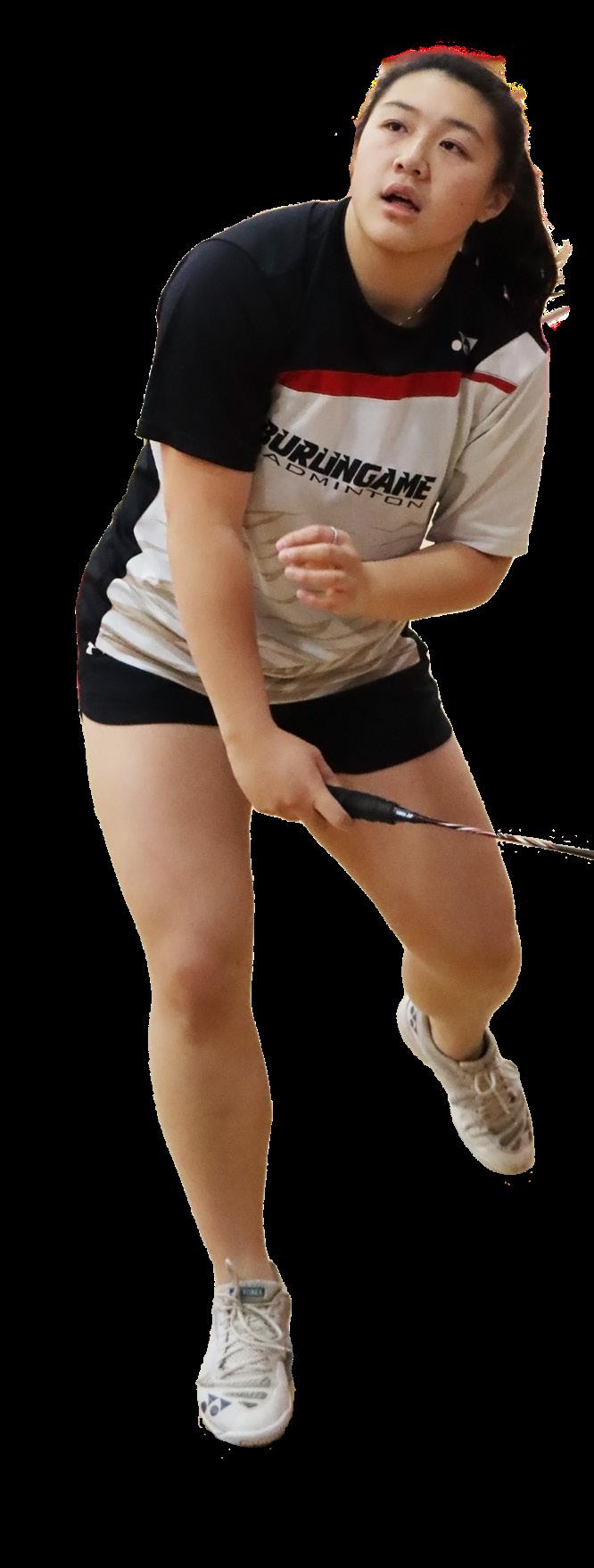
On the badminton team, Jiang has established herself as a leader, and is one of the most experienced players.
“I’ve been playing [badminton] since middle school. at’s almost seven years,” Jiang said. “But I’ve been playing competitively with the high school for four years.”
She has also proven to be a very versatile player for the team, competing in girls’ singles, girls’ doubles and mixed doubles.
Jiang has high hopes for the team this season, but rather than having the goal of winning every game, she believes that the team needs to focus rst on making incremental improvements.
“ e way that I encourage other people is to tell them tips about their game plan and their strategy, not so much of the skill of the student, but you can really win a game by strategy over skill,” Jiang said.
Fortunately, the morale of the team should not be a concern this season.
“I think our team dynamic is great,” Jiang said. “We all have a lot of fun during badminton, a lot of people that watch us play and watch the team just interact with one another.”
AN ACE WiTH BiG GOALS
BY ZACH SHAPIRO Sta Reporter
A perennially successful baseball program, this year Burlingame boasts the reigning PAL Bay Division pitcher of the year: Holden Glavin. In his rst full year of varsity ball as a junior, the le -hander took a historically deep league by storm, garnering next-level attention from Georgetown University in the process.

“Last year we had a solid team and a good foundation,” Glavin said. “A good defense behind me always helps and good coaching from top to bottom allows me to keep improving.”
Although humble in recapping last year’s performance, Glavin impressively nished with a 1.91 earned run average (ERA) and league-best 73 strikeouts. His 10-5 record helped lead Burlingame to another CCS Division III playo run, ending in a championship loss.
I’M GOOD AND i WANT TO BE BETTER
BY MICHELLE MOSHKOVOY Sports Editor
If you asked head coach Bill Smith who he had possibly slotted at No. 1 singles early last season, junior Arda Inegol was a frontrunner. But that was before a hip injury kept him out for his entire sophomore season. is season, Inegol has returned to the team and quickly made his way to the No. 1 position in the team’s rst matches.
“When you’re adding somebody at the top, that makes you a heck of a lot better,” Smith said.
While Inegol has had a tumultuous high school tennis journey, he still has two seasons to prove he’s a top player in the PAL Bay Division.
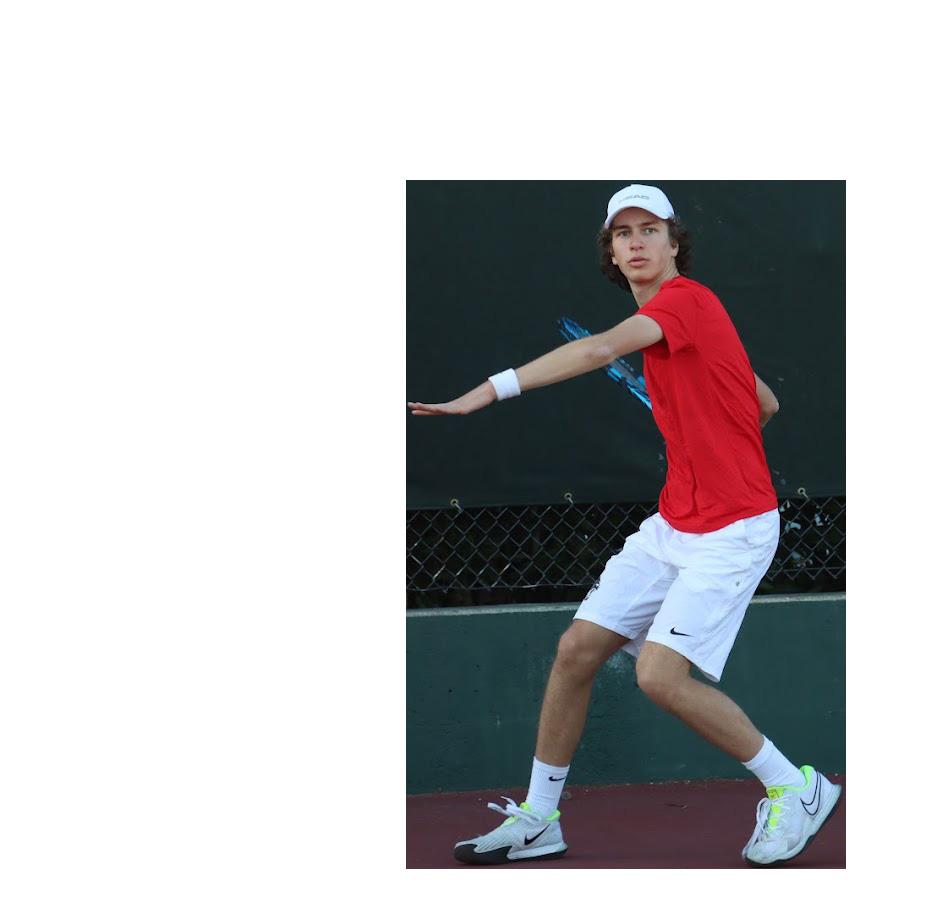
“He still has a chance to recapture what he lost as a sophomore,” Smith said. “I don’t mind saying he walked in as a freshman thinking, ‘I am good and I am going to be better.’ And he’s out [here] working at it…He wants it...He’s taken the challenge.”
“ at’s the one game we all got circled. We want to get back [to the championship], and I want to pitch in that game again; that means more than anything else,” Glavin said.
BY ZACHARY NEWMAN Sta Reporter
MAKiNG THE LEAP READ MORE
Believe it or not, track and eld is not junior CCS Championship runner Avah Reichow’s primary sport. But when she steps on the track, her talent is undeniable.

Reichow is also a competitive gymnast, and the year-round commitment makes her schedule busy. However, her countless hours of gymnastics training has also enhanced her leg strength for running.
“I’ve been conditioning since I was ve, so I have the leg strength to get me through any race,” Reichow said. “I’ve been working a lot on [improving] my endurance.”
Last season her hard work reaped great bene ts in the CCS playo s, logging a personal record in the 400-meter dash to nish in fourth place — just short of qualifying for the state championship meet. is season, Reichow is making the leap, both guratively and literally, to transition and compete in hurdle events.
“[My aim is to] go out, try my best and see what happens,” Reichow said.
SPORT S MARCH 13, 2023 8
PHOTOBY JAKE ROTHSTEIN
PHOTO BY JAKE ROTHSTEIN
PHOTOBYJAKE ROTH S T E I N
PHOTO BY MICHELLE MOSHKOVOY
Get ready for lacrosse
Boys’ team eyes a winning season
BY JAKE ROTHSTEIN Head Photographer
A er placing 6th in the Santa Clara Valley Athletic League and falling to qualify for CCS last spring, the boys’ lacrosse program is on the come up due to experienced leaders and growth in participation.
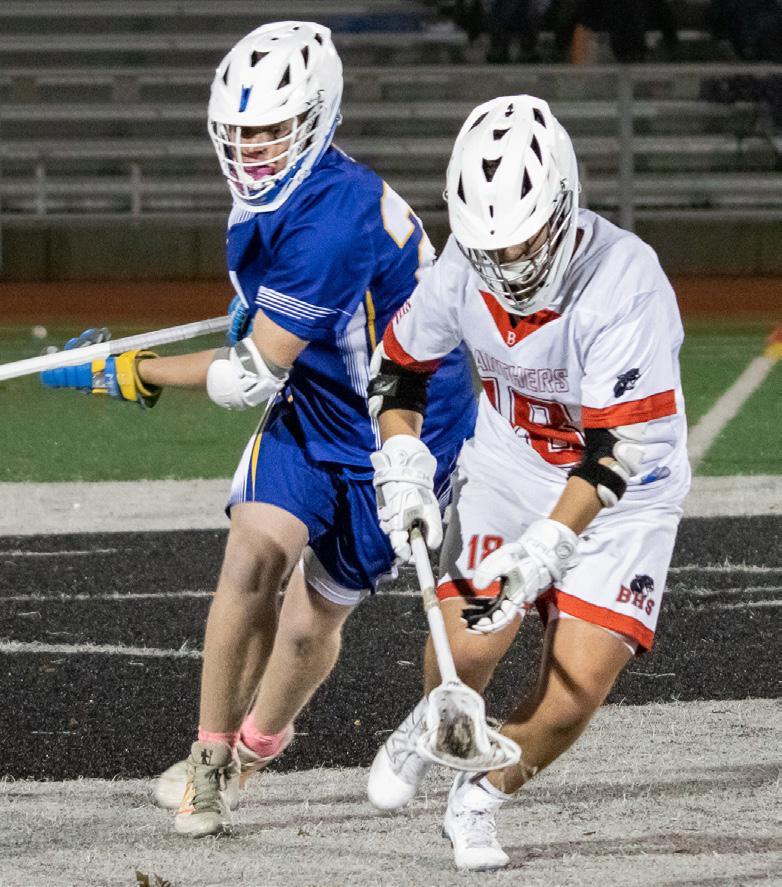
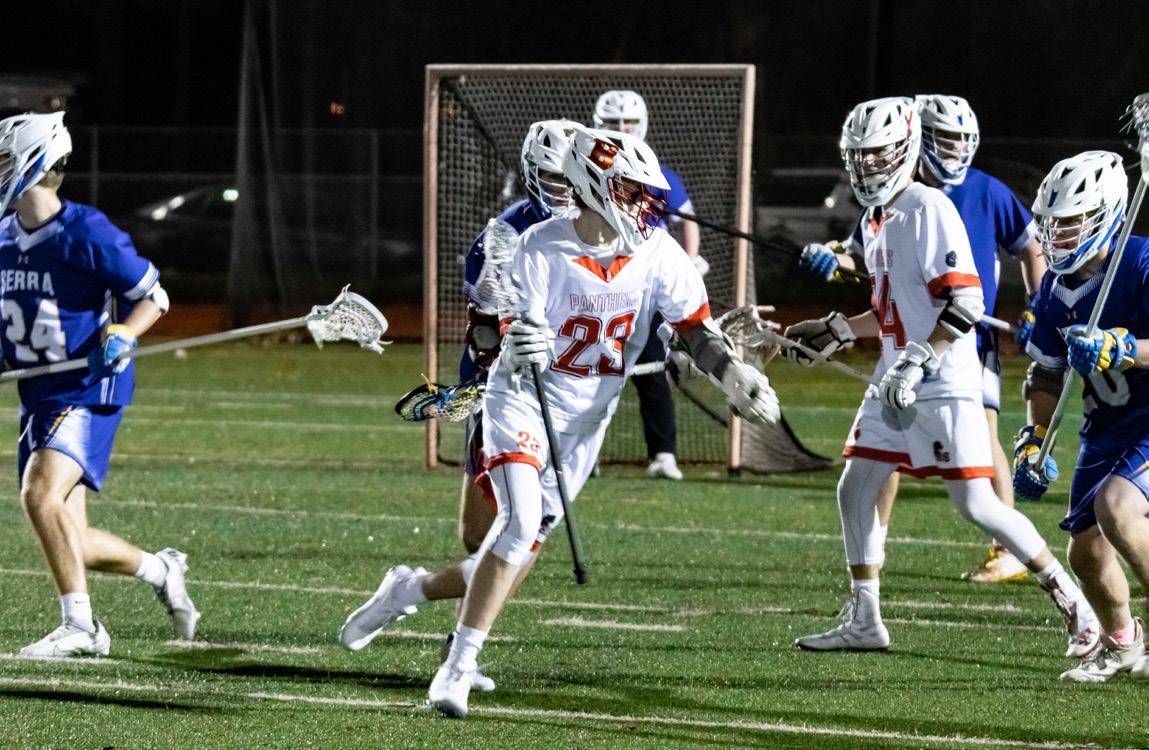
“My sophomore year [2021], we had a big problem — not one freshman played, so we had a very young [varsity] team,” senior captain Blake Sibley said. “[ rough the years] we’ve developed incoming freshmen and sophomores into a JV team, and we’ve been able to have lots of depth and age at the varsity level. I feel like we have got a lot more player engagement, especially a er COVID.”
at improvement was evident in the Panthers’ season opener against Junipero Serra High School on Tuesday, Feb. 28. At hal ime, the Panthers had a 4-3 lead secured by o ensive breaks and lockdown defense. However, the team struggled in the second half — an e ect compounded by the fact that Burlingame was playing against its prior head coach, Ryan Bolanos.
“ e players acted like they were going through a bad breakup,” rst-year head coach Logan
Brown said. “[ e game] was winnable, and we proved [that it] was winnable. e guys lost focus, and they got tunnel vision [a er the rst half].”
roughout the rst half of the game, seniors Luke Newman-Silva, Tate Nelson, Hayden Wilson and sophomore Henry Bradley impressed on the offensive end, each contributing goals. And on the defensive end, senior captain Nabil Balach stood out with his excellent performance.
Even though the game took an unfortunate turn in the second half for Burlingame, the scoreline was a noticeable improvement when compared to last year’s 19-7 blowout loss against Serra. Ultimately, staying physically and mentally focused will be key for the team, according to senior captain Archer Grenier.
“We need to carry our momentum through the entire year… We can’t get ahead of ourselves. We can’t think in any comfortable sort of mindset. We just need to stay focused on what’s ahead and on closing out the game strong,” Grenier said. “We’ve got to play as a team, and we’ll be working on that in the coming practices.”
Because most of the team has played together for three years, the squad is a very tight group, with newer players also tting in nicely.
“We have some new seniors hopping in, and they blend in perfectly,” Grenier said. “ ey have been putting in the e ort out of practice, even watching the lm and trying to get their stu down.”
With the addition of Brown as head coach, the team gains over 20 years of experience as a coach at both the high school and collegiate level. Brown moved to Burlingame with hopes of continuing to grow the program and is excited to help build something special in Peter Umland Stadium.
“ ey are a pretty close-knit group… it’s a brotherhood. ese guys are going to continue to learn to trust each other,” Brown said.
Girls’ team welcomes new talent
BY ELISE SPENNER Managing Editor
At the end of every girls’ varsity lacrosse game, the players huddle around head coach Phil Wang to debrief their performance. But walk by the circle, and you won’t hear Wang talking: Instead, claps and whoops ring out as the girls shout out strong performances from their teammates. You won’t only hear the names of stars like University of Chicago commit Elizabeth Fitzgerald, senior Mimi Cacciato and freshman Haleh Ansari: Instead, many of the shout-outs go to the girls who work around them.
It’s past 8:30 p.m. on a Friday evening by this point, and the temperature is somewhere below 50 degrees Fahrenheit. Most of the girls wear only the shorts and shirts they played in. But they don’t break their huddle until every player’s contributions are recognized — because that’s the sort of team they are.
“Our team is very inclusive,” Fitzgerald said. “ ere’s room for everyone on the team, and everyone obviously has di erent skills and is good at di erent things. And we use those different skills to form one united team.”
at inclusivity is especially important this season, when well over half of the 18-player
roster is new to the team. And as the lacrosse program continues to recover from pandemic-induced challenges, bringing new players in is a focus for head coach Phil Wang and his squad.
During the 2022 season, the varsity and junior varsity teams shared just 34 players — with 12 players on the eld at a time, the two rosters were o en short-handed. But this year, 42 attended tryouts, providing an unprecedented cushion for the program.
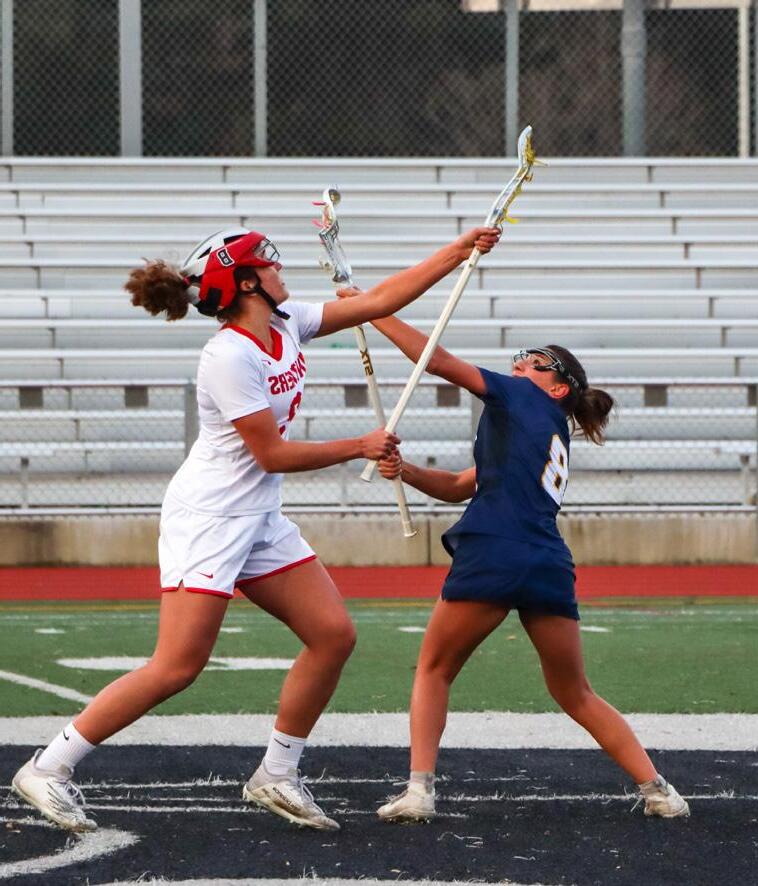
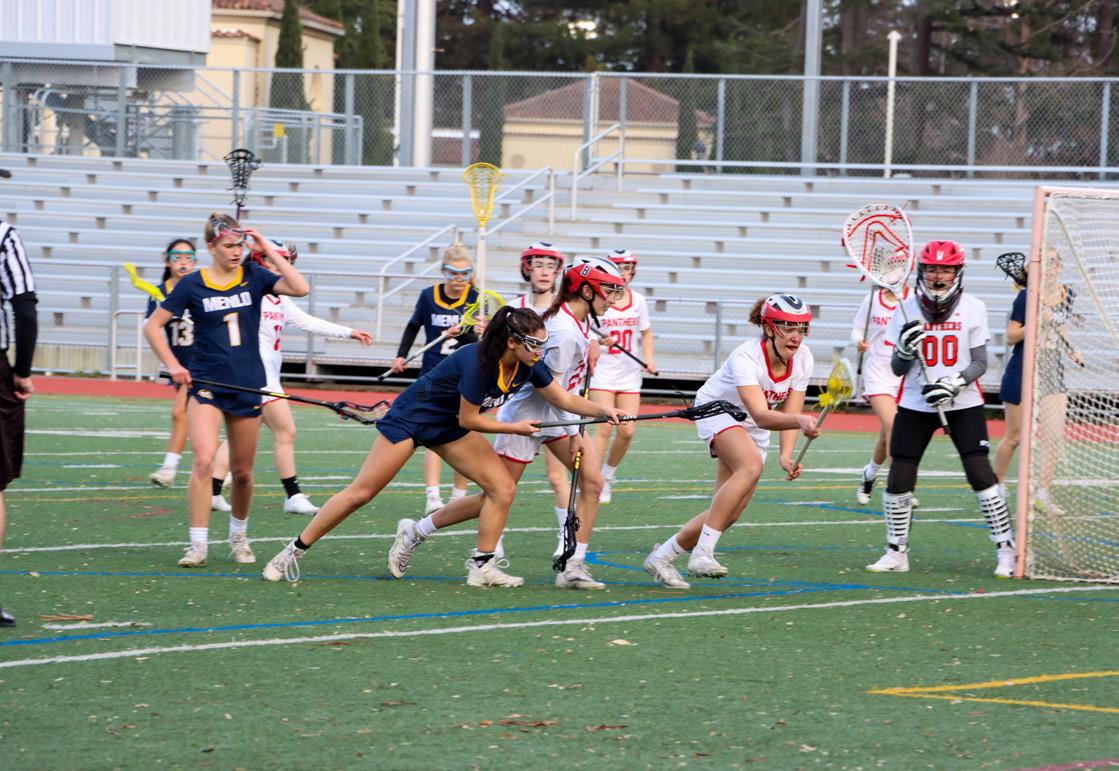
“It’s a step in the right direction,” Wang said. “It’s a strange goal, but at some point, if we’re forced to make cuts, that’s probably a good thing.”
Because lacrosse is so similar to sports like soccer and basketball, it’s easy to jump in during the o season and adjust quickly to the game, the girls said. And, of course, it’s another way to socialize and spend time with friends.
“I thought since a lot of girls were trying it for the rst time that it might be my only opportunity to try it,” said freshman Mika Haggarty, who started playing lacrosse this year and is on the junior varsity team. “I feel like it’s helpful that everyone’s in the same boat. So we all can help support each other.”
Haggarty would make senior Lindsey ompson and co-captain Mimi Cacciatio proud. In
their fourth year on the varsity team, the two are intent on creating a welcoming environment for younger players.
“It’s just making them comfortable and also making them understand that we were in their places at one point and that we were the scared freshmen on the team,” Cacciato said. “Like ‘oh, no, if we drop a ball, it’s the end of it,’ but it’s really not.”
It’s been a pre-season roller coaster for the Panthers as they work to build chemistry and relationships before league play. On Friday, March 3, Burlingame lost 13-3 to an impenetrable Menlo School squad. But for the Panthers, playing against tough teams is a valuable test of their mentality and ability to support each other.
“We had a conversation last practice about [how] there’s a good loss and there’s a bad loss… It’s just all about how you handle it a er the game,” ompson said. “ is is de nitely a good loss.”
Freshman Haleh Ansari, an early standout, was everywhere at once in the game — winning draws, chasing players down and scoring her fourth goal of the season.
“I don’t know if [Ansari] is quite ready to take the spotlight yet,” Wang said. “She’s got a lot of skills. I’m not sure if she knows quite how good she is yet.”
SPORT S MARCH 13, 2023 9
Top: Sophomore attacker Henry Bradley attempts to penetrate through Serra’s defense during their game on Tuesday, Feb. 28.
Bottom: Senior Jacob Maslenko wins a draw in the same game.
Senior Ellie Neuman has emerged as a pivotal player.
Top: Neuman drives to the goal in a match against Menlo.
Bottom: Neuman challenges a draw in the same game.
PHOTOS BY ELISE SPENNER
PHOTOS BY JAKE ROTHSTEIN
Save your money, “Cocaine Bear” severely disappoints
BY DANNY CONWAY Sta Reporter
It should come as no surprise that I — a self-proclaimed lover of animals and intoxication — was immediately drawn to the many, many “Cocaine Bear” commercials that have circulated the Internet in recent weeks.
e title, so simple yet profound, explains the premise of the lm perfectly: a bear does crack. Imagine “Narcos” meets “Snakes on a Plane” with a touch of “ e Berenstain Bears.”
e movie is based loosely on the true story of a lucky American black bear who snorted millions of dollars of lost cocaine in 1985. Director Elizabeth Banks takes many creative liberties in the cinematic adaptation of the tale, and the viewer follows along while the wired bear goes on a killing spree in a Georgia national park.


e movie has been a relative box o ce success, grossing $53.2 million with a roughly $30 million budget.
Walking into the theater, I had hoped that “Cocaine Bear” would be a fun ick. I didn’t expect anything revolutionary, but I thought I would get in a few laughs and then move on with my day.
at was not the case, however — while I still think it’s a
great premise, the writing made the brief 95 minutes feel much longer. I can’t say I would recommend the lm for my fellow sober movie goers.
ere is not one main human protagonist in the lm, but rather a large ensemble cast whose stories eventually intertwine. e late Ray Liotta plays Syd, the slimy drug kingpin in his last theatrical performance. Syd sends one of his dealers, Daveed (O’Shea Jackson Jr), along with his disgruntled son Eddie (Alden Ehrenreich), into the forest to fetch the lost product. Elementary schoolers Dee Dee (Brooklyn Prince) and Henry (Christian Convery) skip school to venture into the wilderness and also encounter the bear. Dee Dee’s do-it-herself, single mother Sari (Keri Russel), who is furious a er hearing that her daughter skipped school, follows Dee Dee into the park. Cookey park rangers Liz (Margo Martindale) and Peter (Jesse Tyler Ferguson) also get involved in the mix, but end up being more incapable than helpful to the terri ed park goers. Local detective Bob (Isiah Whitlock Jr) hears of the situation and makes his way down to the park to nd potential leads on the lost cocaine.
e dialogue in “Cocaine Bear” is painfully bad. On pa-
per, the ensemble of eccentric characters seems like the recipe for lots of laughs, but instead of exploring the dynamic between the characters, they are all split up into separate story lines. Most of the laugh lines come in the form of one liners, which I found to be corny and cringe-worthy. I guess lines like Henry exclaiming “I guess I’m a coke head now!” is kind of funny and cute, but it just feels so safe and unoriginal. e lm is far from being “family friendly” due to its abundance of gore and
heavy portrayal of drugs, but many of the jokes felt straight from a PG-13 disney channel comedy. Part of me wonders if all the gore was added in post-production to add an edge to the lm.
e moments when the computer-generated imagery cracked-up bear is on screen are the highlights. ere are some great physical comedy sequences, whether that be the bear rabidly sni ng in pursuit of more cocaine or eating one of its victims organs like spaghetti, but
the gore and shock value of a bear doing cocaine loses its novelty quickly.
While “Cocaine Bear” may have disappointed me, I am hoping it has created a new sub genre of movies about substance-abusing animals. I would love to see potential thrillers like “Heroin Horse,” “LSD Parrot” and “Cigarette Cat” on the big screen in the coming years.
“Cocaine Bear” le me ending for more substance, much like its addict protagonist.
Minorities deserve respect for more than a month
e rst day of any given month can be recognizable for one reason — companies and school districts change their branding and online pro les to honor the group being celebrated during that given month.

Designated months that celebrate the history of speci c minority groups are still a relatively new concept that has gained popularity over the last decade.

Whether it be Black History, Indigenous History or LGBTQIA+ history, it’s during these months that society honors people from these groups.

Companies, businesses and even schools o en change their websites, social media platforms and buildings to celebrate and show solidarity. IKEA, for instance, puts out ags to celebrate Pride Month, but unlike other companies, leaves them up when June ends—as companies should do.
While tactics such as rainbow packaging and changing social media icons may seem altruistic at rst glance, companies and districts have large incentives to
hype train. With the LGBTQIA+ community growing as one of the fastest-growing minority segments in the U.S. according to government census data, the group has an estimated buying power of $1.4 trillion—acting as a large incentive for companies to advertise to the group.
Even though targeting minority groups in advertising campaigns sounds harmless, a study by the multinational conglomerate Unilever found that 71% of participants “believe stereotypes in media are harming the younger generation” while around half of participants surveyed from marginalized communities felt that they were stereotyped in some way through advertising.

Companies should proactively promote inclusivity for all and care about minority groups no matter the month. For example, they should not wait for Black History Month to feature and honor African-American leaders and instead have these important discussions year-round. Companies should also make inclusive social media posts whenever possible, since they can reach a broader audience through their online platforms.
e San Mateo Union High School District (SMUHSD) puts up pride ags only during pride month; moreover, it does not host events and rarely puts up supportive social media posts. SMUHSD should be more active in promoting history months and supporting minority groups, which would make students in the district more tolerant of others. e district should also put up the pride ag throughout the calendar year and demonstrate appreciation for the LGBTQIA+ community.
History months are a way for society to honor the contributions that minority groups have made to society, not an excuse for companies to exclude them for the majority of the year while reaping the bene t of their advertising.
Why should we raise pride ags in June but take them down when July begins? Companies should feel sincerely inclined to support all minority groups by hanging ags, celebrating diversity and promoting inclusive history year-round. Minorities deserve to be appreciated all year long.
BY THE BURLINGAME B EDITORIAL BOARD GRAPHIC BY SOPHIA BELLA
OPINION MARCH 13, 2023 10
PHOTO COURTESY OF UNIVERSAL PICTURES
e “Cocaine Bear” roars in rage a er dusting o a line of blow.
El Camino eucalyptus face removal and replanting
BY ALEX KELLY Business Manager
A er years of collaboration and planning, Caltrans and the City of Burlingame have nalized a plan to remove and replant most of the eucalyptus lining El Camino Real as part of the El Camino Real Roadway Renewal Project. e design and construction will start in summer of 2024 and will be completed in 2026.
e project has faced its fair share of obstacles. Collaboration started all the way back in 2017, when members of Caltrans, city council members Michael Brownrigg and Emily Beach, along with other city ocials and community members, joined together to create the El Camino Real Task Force.
“We sat with Caltrans and we sat with tree experts, and we tried to gure out how we could do two things. One, make the road make El Camino safer for pedestrians and for motorists and for cyclists but also two, protect the canopy,” Brownrigg, the city’s current mayor, said.
It doesn’t take long driving or walking on the Burlingame stretch of El Camino Real to notice the street’s issues. Sidewalks are nearly impossible to walk on and not compliant with the Americans with Disabilities Act (ADA), cracks and potholes run throughout the road, the sightlines are terrible — not to mention the risk of ooding, which has been exacerbated by the recent rain storms. All of these problems are rooted — so to speak — in the street’s iconic eucalyptus trees — essential to Burlingame’s character and moniker as “ e City of Trees.”
e Plans
Although Caltrans owns and oversees the project because El Camino Real is a state road, the city government has worked to ensure that road will not be widened to a six-lane highway, and that some of the original grove of eucalyptus will remain. ey have also mandated that, even though many eucalyptus will be removed, just as many new trees will be planted in their place.
Speci cally, city o cials are recommending that Caltrans replace the blue gum species with Eucalyptus Citriodora, a variant with thinner trunks. is would allow for better sight lines on El Camino, but still provide the tall growth and thick canopy of the blue gums.
“We’ve been discussing and guring out how to best approach [remodeling El Camino] so that we preserve the historical character of the tree grove and replant it in a way that will be beautiful for future generations,” Beach said.
e History
e grove has been important to Burlingame for generations. First planted in 1870 to make moving to Burlingame more appealing, the corridor of blue gum eucalyptus has been a staple of the town for over 150 years. Even when Millbrae and San Mateo got rid of their trees in favor of a widened street, Burlingame kept its urban forest. Burlingame Historical Society president and member of the El Camino Real Task Force Jennifer Pfa recognizes that though the removal may be necessary,
it’s still sad to lose a major part of Burlingame’s history.
“[ e trees] are the character of our city, and people for hundreds of years have known us by that character, so it’s scary and sad,” Pfa said.
e Problem
Despite the importance in character, many feel that it’s time to leave the eucalyptus behind a er the signi cant road damage. Burlingame senior Anna Way had her tire punctured while driving on El Camino Real by a Eucalyptus root jutting into the road.
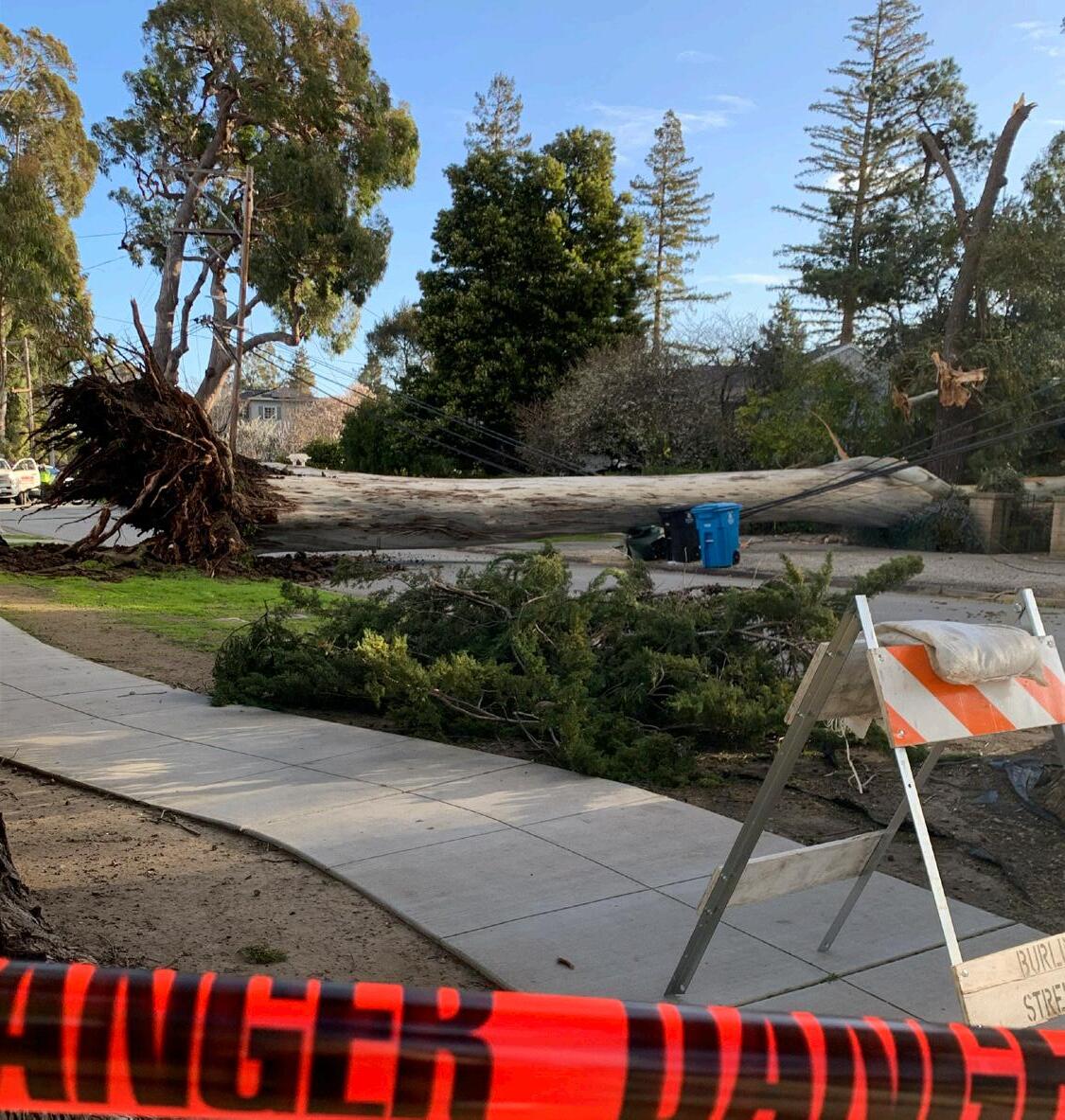
“Every single time I drive past that spot where I got a at tire, I always switch lanes, and it could easily happen to anyone,” Way said.
It’s not just dangerous to motorists, though. Under heavy winds, the tall eucalyptus trees can become unsteady and pose a threat to pedestrians and buildings. At the beginning of 2023, a eucalyptus fell across the Caltrain tracks. Luckily, the damage was minor. However, in the recent windstorms on Tuesday, Feb. 21, a eucalyptus fell over in the Easton Addition, hitting a house and knocking out power for a much of the neighborhood. While no trees have fallen on El Camino Real recently, these scenarios show why keeping more of the original grove is not possible. Implementing sidewalk meandering — curling the path of the sidewalk around the trees — could destabilize the trees, and the updates to El Camino Real planned by Caltrans will certainly require the removal of the trees whose roots have disrupted the road.
e Future
When multiple trees on Easton Drive became unstable, the city removed them, signicantly changing the complexion of the street. However, only removing some of the trees on El Camino Real is not an option.
e blue gum relies on those around it for wind protection, meaning a partial removal would put El Camino Real in danger. While Caltrans and the city have worked to save as many trees as possible, they have estimated 90% of the trees need to be removed either due to destabilization or a current threat.
“As [Caltrans] are going through this they’re evaluating that there are certain tree groves that they can preserve and meander around and kind of also
give better line of sight,” Beach said. “ ere are certain trees that need to be removed because they’re just in the way and they’re going to be destabilized with the construction.”
While it may take a few years, the canopy and character of “ e City of Trees’’ will return. And this will happen while El Camino Real is made safer, more accessible to pedestrians, resistant to ooding all while remaining just four lanes.
“Yes, some of the trees — not all, but many of them — are going to come down. But they are going to be replanted and long range, I don’t believe it’ll change the character. I think it’ll make El Camino more beautiful. It’ll make it safer,” Beach said.
Hardesty: from professional studio dancer to math teacher
Rebecca Zielkowski said. “She’s amazingly hard-working.”
Teaching has been part of Hardesty’s life since she led swim lessons at the YMCA and adult aerobics classes as a teen in St. Louis. And now in her second year at Burlingame and 14th year as a teacher, Hardesty has le a positive mark on many of her students and coworkers.
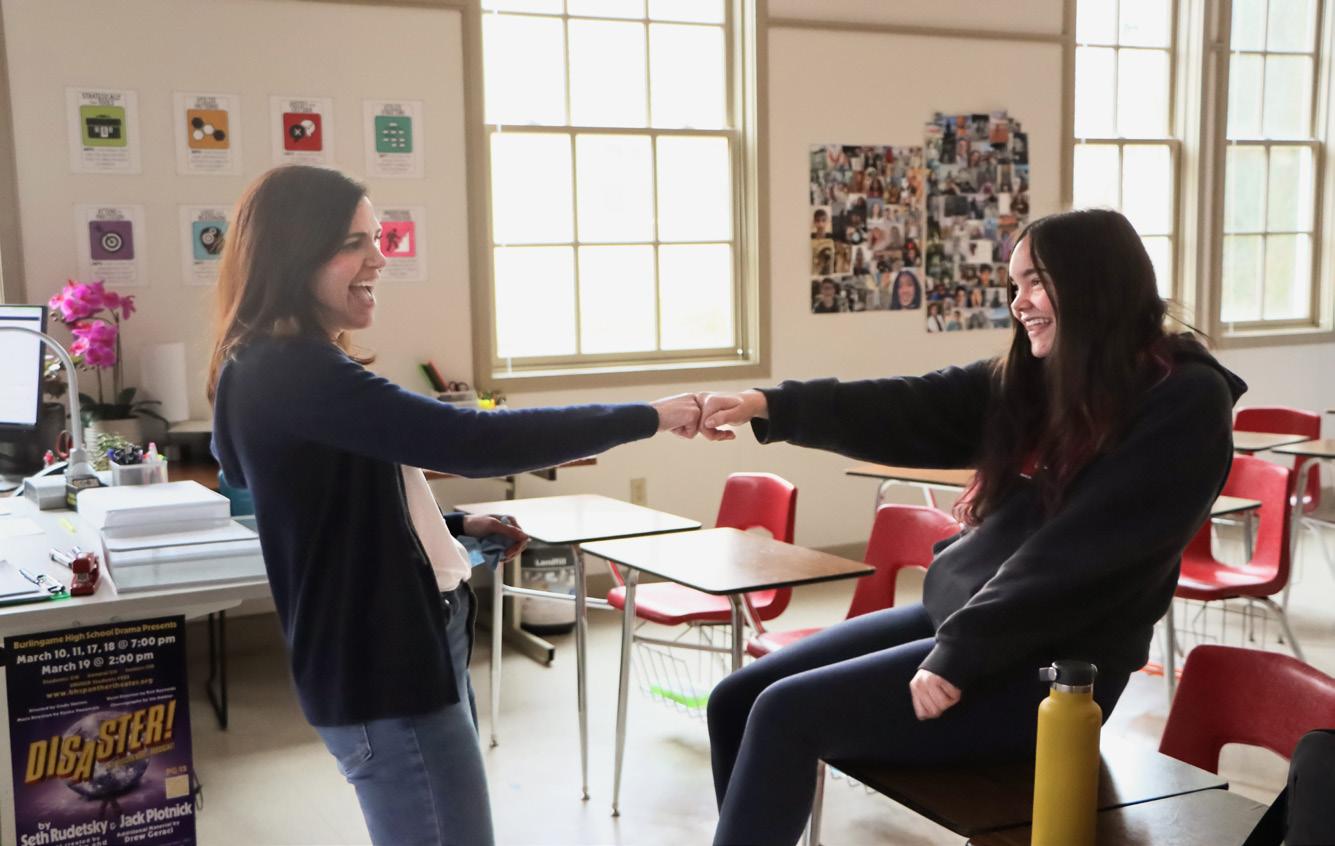
But although she received her teaching credentials from Indiana University in 1992, the math teacher’s career would actually be far from linear. A er all, 2023 - 14 ≠ 1992.
“All my time was spent dancing, and not at school. I liked math, but I would have never guessed that I would be a math teacher,” Hardesty said.
And even while juggling a college education, the company ew her out to Las Vegas, New York and other locations for trade shows. She also worked in Hokkaido, Japan for a summer, as well as on a cruise ship that traveled from Long Beach to Cabo San Lucas. Eventually though, her body gave out.
teaching degree, that Hardesty would return to teaching at Freedom High School in the East Bay.
“I was super nervous trying to get my foot back into teaching,” Hardesty said.
She taught there for ve years, before moving to Cincinnati, Ohio amidst the 2014 economic downturn. Finally, she came back to California to be closer to her now-adult children, arriving at Burlingame in 2021.
“I’m so glad that I landed doing this because I’m grateful for my job every single day,” Algebra II teacher Carol Hardesty said. However, Hardesty didn’t start teaching long term until 17 years after she graduated from college.
BY MICHELLE MOSHKOVOY Sports Editor
“She’s like a mother, but in a teacher way — like a ‘teacher mom,”’ senior Sophie Matthews said of Algebra II teacher Carol Hardesty.
It’s not uncommon for Hardesty to have her door open
throughout the school day to help students with logarithmic equations or be someone they can simply talk to, like for Matthews.
“Anytime I go into Ms. Hardesty’s room, she’s helping someone. I go to talk to her, and I can’t because she is always helping like ve kids,” math teacher
at’s partly because from age 19 to 25, Hardesty was a professional dancer for a former entertainment company, performing during college and a er she graduated with her credentials.
If it were up to Hardesty at the time, she would’ve moved to New York City a er high school to pursue dreams of being a Rockette. She had danced since age 3 in ballet, tap, jazz and tumbling — and even spent her senior year in high school as an NFL cheerleader.
“It turns out my mom was right. She was like, ‘If you injure yourself, then what are you gonna do?’ And guess what happened, I injured [my foot],”’ Hardesty said. “I tried to keep going for a bit, and it was just too painful… You have to have a plan B.”
In 1995, she nally got her rst teaching gig in Seattle. Newly married, Hardesty then became pregnant a er her rst year and was a stay-at-home mother for the next 13 years.
It was not until 2009, nearly two decades a er obtaining her
Ultimately, Hardesty has taken every course of her life in stride. And in one that has o en had unexpected turns, she sees Burlingame as her nal career stop.
“[Dancing and teaching] are so di erent, but I love them both equally. I do enjoy knowing what to expect,” Hardesty said.
“You grow to love the community, the kids, and the other sta [as a teacher]… I told my husband, this is it. I’m staying here. I love it here.
COMMUNITY MARCH 13, 2023 11
PHOTO BY MICHELLE MOSHKOVOY
PHOTO BY ALEX KELLY
A eucalyptus tree fell across Easton Drive, hitting power lines and a house during the severe wind conditions on Tuesday, Feb. 21.
STUDENTS PARTiCiPATE iN BREAKiNG DOWN THE WALLS
PHOTO BY JACKSON SPENNER
BY BRINDA IYER Sta Reporter
“Step over the line if on some days, you come to school and you feel invisible.”
e resounding thud of several shoes hitting the oor echoed throughout the gym when Breaking Down the Walls organizer Mike Walsh posed this statement to approximately 200 students. ose that stepped forward scanned the room, surprised to see that dozens of others were feeling the same way.
It would be hard to nd 10
seconds that better encapsulate what Breaking down the Walls is all about. e week-long program, hosted at Burlingame this March, gave students the opportunity to connect with their fellow classmates and share stories. Although this is the third year that Burlingame has hosted Breaking Down the Walls, it was the rst time that freshmen, sophomores and juniors were required to attend the event.
“A lot of people thought that [the event] would be like a joke,” freshman Anya Malhotra said.
“Just something no one would
take seriously, and no one would really take anything away from the day.”
Despite that initial mindset, Malhotra, along with the vast majority of students, discovered an entirely new perspective by the end of the day, and was moved by the battles her classmates fought in silence.
“ e premise is that it’s hard to hate someone when you know their story,” Walsh said. “We tend to put a face to the story, and that person becomes far more humanized and our level of empathy shoots up, and we just become kinder, more loving human beings.”
e day began with light icebreakers to foster in-depth conversations between students who were once strangers.
Kids then got into small assigned groups, each headed by a student volunteer. e groups bonded with brief games like Two Truths and a Lie and the Human Knot game.
A er lunch, the content grew far heavier. Students stood on either side of the gym as Walsh read from a list of personal statements covering a range of

MEET BURLiNGAME’S VERY OWN FOOD INFLUENCERS

Senior Marco Rice started @thebeasteats on TikTok in December of 2022. A er school and on weekends, Rice visits local fast-food restaurants with friends who help him lm as he taste-tests menu items. His videos begin with a signature “let’s get into it” and end with a rating on a scale of 1-10.

topics, including eating disorders, suicide and socioeconomic inequality. If the statement applied to students, they stepped forward, o ering a visual way for kids to feel supported while sharing their stories.
Sophomores So a Flores and Emma McNamara agreed that the morning activities were quite awkward. ey said the pressure to make small talk with their unfamiliar partners created a sti atmosphere.
ey weren’t alone in feeling this way. While Walsh was at a school in Seattle, a student came up to him and expressed their dislike for the bonding activities, saying that the deep topics discussed in the a ernoon felt far more important.
“[ ey were] absolutely right,” Walsh recalled. “But we have to do that stupid stu , so we can get to the real part. Someone said to me that the more they had the lighter conversations, the more they started to feel connected to everyone else.”
e “real conversation” refers to the Crossing the Line activity. With deep and highly introspective prompts, the activity
revealed vulnerability in every student in the room. A sense of safety and community was fostered, and some even felt comfortable crying.
“You don’t have to explain yourself,” sophomore So a Flores said. “ ere’s no extra pressure and you’re not required to say anything. [During the activity] I shared something I had never shared with anyone before. And I de nitely saw people were starting to tear up because it was very hard, they were very di cult questions.”
Although each student processed their emotions di erently, they all said it increased their empathy and compassion for their peers.
“Sometimes [at school] you feel like you’re being judged, or like there are negative things at play,” freshman Natalia Spaelti said. “But Breaking Down the Walls was an insanely comfortable and emotionally-safe environment for people to share whatever was on their minds. I think people will try to create that more outside of [the event], now that they’ve been exposed to it.”
Inspired to try every Trader Joe’s salad, senior Rinko Miyoshi began @rinkosmuch, a food review and recipe account, in late January.
“I was like, ‘Why not try every single one and see which one’s my favorite?’ because they all looked interesting,” Miyoshi said. “And so I thought it would be fun to keep kind of a log of what’s best and just share it with people.”
is year, Miyoshi is living with a host family while her parents reside in Japan, leaving Myoshi responsible for maintaining her health. Hoping to inspire others to eat healthy food, Miyoshi began posting recipes and videos of her cooking.
“On my account, I post a lot of recipes that tend to be more healthy and make me feel good, so I like sharing that with other people,” Miyoshi said. ey’re pretty quick, easy recipes that anyone can follow, so it’s to inspire other people to try to eat healthy but have really yummy meals.”
Miyoshi’s account caters towards anyone with even the slightest interest in cooking. Although her account began with friends in mind, her vid eos have gotten views from outside users as well.
“No one else eats [my cooking] but me so I feel like it’s fun for me to still be able to share with other people,” Miyoshi said. “Even though they’re not physically tasting, they get to see and enjoy it visually.”
Rice has always eaten out frequent ly. Inspired by food accounts on his feed and encouraged by his parents, he decided to create a page of his own. e account is something he does primarily for fun and the posts come together rather spontaneously while he’s out with friends.
“I just do it for fun, I don’t really care too much about the likes and views or the followers or anything,” Rice said. “ e goals are just to have fun with it and learn a lot about online stu , social media I could use later in my life.”
Rice enjoys having an avenue to express his opinions and values feedback from followers around town. At the same time, he’s gained a greater understanding of the challenges that come with being a content creator.
“I’ve also learned you can’t please everyone,” Rice said. “Everyone is going to have their opinion on social media, and several disagree or agree.”
Senior Julia Brooks launched @foodaccounto in early January of 2021, months before food bloggers took over social media.
“I kind of just post food that I have enjoyed,” Brooks said. “I take photos and then post whatever I like so that people that follow me can try the same things that I really enjoyed.”
Starting the account was an easy decision for Brooks, who was already showing her friends pictures of food she was eating and telling them about new places. e account just gave her a wider audience.
“It’s more something I do for fun. I like looking at all the pretty photos and having them all in one place where I can look and I’ll love,” Brooks said. At the same time, being on Instagram has encouraged Brooks to try new foods and step outside of her comfort zone.
“I actually tried oysters for this account, and now oysters are one of my favorite things to get when I’m on vacation,” she said.
At the heart of Brooks’s page is a genuine love for food. She launched @foodaccounto to make her happy, and she feels as though she can be her genuine (or) authentic full self in her posts, she said.
“Since I don’t put that much e ort into this account, and I do it for fun, I don’t get anything out of it but pure joy,” Brooks said. “Rather than my social Instagram account which brings a lot more stress and anxiety… this one is just kind of like my happy place.”

STUDENT LIFE MARCH 13, 2023 12
Breaking Down the Walls returned to Burlingame this March to foster community and connection between students.
@FOODACCOUNTOFJ @RiNKOSMUNCH @THEBEASTEATS
REPORTiNG BY KRiSTiE KiM
PHOTO BY KRISTIE KIM
PHOTO BY KRISTIE KIM
PHOTO BY KRISTIE KIM

 BY ELISE SPENNER Managing Editor
BY ELISE SPENNER Managing Editor













































